
| Ideas for the instrument panel |
Even dealing with the fact that this will take some time from now, I'm dreaming of a glass cockpit. The EFIS idea looks great to me and to be hounest, evolution and innovation is something I'm on a daily base in contact with... So, all discussions with traditional pilots who argue that all electronic looks are not ergonomical during flight, or, "you will loose the basic feeling of real flying" don NOT change my opinion. The only argument that can change my opinion from now, is the financial point of view... The only reason why I would change my idea is the cost that would raise above my budget for this project. But, believe me, I would rather prefer to keep this bird on the ground for some more time, instead of going back to a basic "clock"-panel. Nevertheless, this basic view is also very nice and OK. But, again, I prefer to put innovation and technology in my cockpit because this is also a part of flying for me. But, that's my opinion and I DO appreciate other opinions in this field as much as I defend mine... So, let's hope that the future will be positive enough to force my dream...
And now, ... what are my dreams...
| EFIS D-100 and EMS D-120 from Dynon |

Dynon's EFIS-D100 is the most affordable large screen Electronic Flight Information System on the market today. Based on the best-selling EFIS-D10A, the 7" wide-screen display features large, easy to read text and graphics and is capable of displaying multiple pages side by side in a split-screen format. The instrument integrates multiple flight instruments, including airspeed, altitude, gyro-stabilized magnetic compass, turn rate, slip/skid ball, bank angle, and vertical speed. Other useful functions include a clock/timer, g-meter, voltmeter and density altitude/true airspeed calculator.
The EFIS-D100 features a 7” diagonal, color LCD which boasts the highest resolution in its class. The stunning display enables split-screen viewing to augment the primary EFIS data with other pages of information called up by the pilot. Six buttons arranged along the bottom of the screen serve as the interface to the softkey-driven menu system for easy access to in-flight functions and setting pilot preferences.
Dynon's advanced ADAHRS (Air Data, Attitude and Heading Reference System) integrates over a dozen solid-state sensors that deliver exceptional performance and reliability. With the exception of the remote compass, the ADAHRS is built inside the EFIS-D100 instrument housing, saving installation time and space. Each ADAHRS undergoes a rigorous calibration regime at the factory to ensure accuracy over its full operating range. Unlike mechanical gyros, Dynon's rugged design is tolerant to aggressive flight maneuvers, automatically corrects itself anytime its gyros capabilities are exceeded, and cannot be damaged by aerobatics or unusual attitudes.
Dynon's EFIS-D100 utilizes an embedded, multi-processor design that delivers real-time performance and stability. This purpose-built design is unencumbered by burdensome operating systems that typically slow down performance and require long boot times. Dynon's software design enables complete control to maximize execution speed and deliver robust reliability. A hallmark of the EFIS-D100's performance and a great safety feature is its ability to display the correct attitude within a few seconds of being powered on while in flight.
A unique safety feature available from Dynon is its optional AOA/Pitot that combines Angle-of Attack (AOA) and airspeed sensing into a single pitot design. The AOA capability assists pilots on approaches and generates an alert signal for audible annunciation whenever nearing stall conditions.
To guard against a power failure scenario, the EFIS-D100 may be optionally equipped with a Li-Ion Backup Battery. When power loss is detected, the instrument will automatically notify the pilot and immediately begin running on battery power for a minimum of 1.5 hours, enabling a safe landing.
The EFIS-D100 is equipped with a PC serial interface which provides the capability of uploading up to 25 user-defined lists for use as checklists, aviation data or other information that pilots wish to keep handy. The PC interface additionally facilitates downloading lifetime free firmware updates from Dynon's website.
Any cockpit equipped with more than one Dynon instrument can benefit from the connection capability that comes via the Dynon Smart Avionics Bus (DSAB). When linked via DSAB, pages displayed on one instrument may be shared across the bus for display on any other Dynon instrument. DSAB not only allows you to share the fun with your co-pilot but delivers any Dynon generated data directly to the instrument in front of you whenever you call upon it.
Items supplied with each EFIS-D100 include:
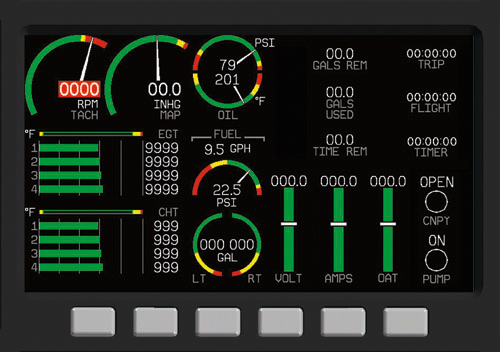
The EMS-D120 is a large screen Engine Monitoring System (EMS) that blends traditional analog gauges with newer digital technologies. The EMS-D120 replaces up to 16 different types of gauges which are displayed on a stunning 7” diagonal color screen. The sunlight readable, color display and softkey menu system result in a user-friendly instrument that enhances overall safety and peace of mind.
What makes the EMS-D120 so powerful is its ability to continuously monitor up to 27 available sensor inputs that cover the engine, fuel and other miscellaneous systems and annunciate any abnormality immediately upon detection. This constant scan significantly reduces the pilots workload while providing a more thorough and consistent review.
A split-screen display environment provides pilots with an excellent overview of the system coupled with additional pages of auxiliary information all available upon demand. Each of the color graphic pages are designed to promote easy visual scanning for interpretation of the current measurements relative to their normal/abnormal operational limits.
Unlike many other similar systems, Dynon's EMS-D120 is easy to setup while simultaneously supporting a high degree of configurability to accommodate a variety of different engines and pilot preferences. The default boot-up or start-up screen example depicted above contains two separate pages on a split-screen format. During the initial setup, installers determine which gauges are indicated, their operational ranges, and whether an alarm is manifested along with its behavior. Info Items may be added to present the specific needs of the particular engine, aircraft or pilots preferences.
This degree of engine specific and pilot preferential customization when combined with a multi-page type of display and pilot configured checklists all add up to provide a unique presentation tailored to fit almost any need.
Dynon offers a variety of probes to accompany the EMS-D120 instrument with very attractive package pricing. The probes offered by Dynon are optimized to support a variety of engines including Lycoming, Continental, Rotax, and Jabiru. Probes may also be purchased individually to monitor other engine types not specifically accommodated for by Dynon's probe packages.
Airplanes with existing engine sensors may already be compatible with the Dynon EMS-D120 system. The EMS-D120 was designed with the intention of retrofitting some of the previously popular, non graphical systems like Grand Rapids EIS systems and Rocky Mountain Inc, Micro Monitors. While not 100% backward compatible, replacement costs are minimized to the extent possible. Please review the specifications and sensors charts on this website for additional detail
Items supplied with each EMS-D120 include:
| Trio Avionics Autopilot |
The EZ Pilot autopilot seems to become my choice. Some specs...
You can see a nice Flash animated presentation by clicking here...
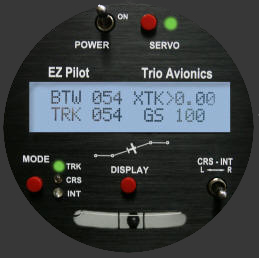
The EZ autopilot is a modern solid-state navigation system designed to accurately track a GPS flight plan or "Go To" Course that is entered into a handheld or panel mount GPS Receiver. It also acts as a basic wing leveler when no GPS is available.
The pilot simply enters a flight plan into the GPS and presses the Servo button. The EZ Pilot then precisely tracks the flight plan.
If the pilot wishes to deviate from the programmed flight path, the Mode button is pressed to enter the Course mode and track any bearing selected with the "L-R" switch. The new bearing will display on the readout and the aircraft will track that bearing.
An Intercept mode (with adjustable intercept angle) is available to steer the plane back to the original flight path.
A remote Servo Disconnect switch provides instant release of flight controls. Holding the switch down for three seconds or more enables Pilot Command Steering. This allows the pilot to manually fly the aircraft to any new heading and, upon releasing the switch, the autopilot will track that course.
A convenient Display switch allows the pilot to read the Waypoint Designator, Ground Speed, Distance to Waypoint, Time to Waypoint, Crosstrack error, Track Offset Position and a graphic Turn Coordinator.
Three navigation modes provide maximum flexibility:
1. Track mode (TRK)
- used for area navigation tracking a host GPS flight plan (or GOTO data).2. Course mode (CRS)
- provides vector navigation as illustrated below. CRS also allows tracking a specific pilot-selected course when the host GPS route function is not in use. CRS mode uses the GPS signal to provide the aircraft groundtrack.3. Intercept mode (INT)
- used to intercept a predefined GPS desired track (DTK) as illustrated below. The INT mode also uses the GPS signal to provide the aircraft groundtrack.
The EZ-1 Altitude Hold
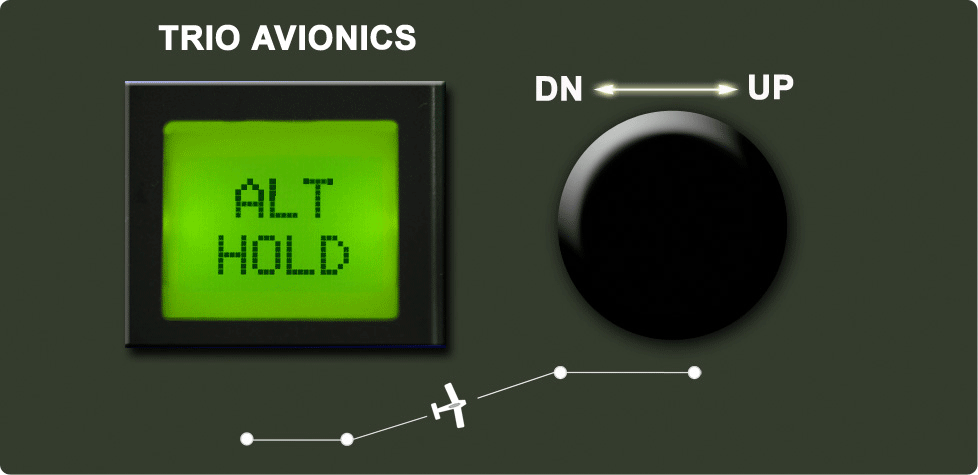
The Servo

INSTALLATION KIT and WIRING HARNESS found a nice installation kit from SafeAir1.
You can see it on the website. The install kit includes:
MANUALS
Both manuals of these EZ systems are available here. You can read them online but if you like you can download them in PDF format. Enjoy...
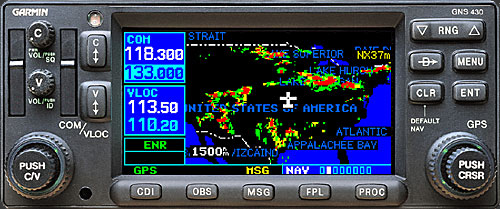
The GNS 430, designed as the first in a line of new aviation products, is an equally versatile panel-mounted companion to the GNS 530. It is a WAAS-upgradeable IFR GPS, Com, VOR, LOC, and glide-slope with color moving map in one multipurpose unit. The TSO'd VHF Com offers a choice of 25 kHz or 8.33 kHz spacing for 760- or 3040-channel configuration respectively. A huge Jeppesen database (that can be updated with a front-loading data card) contains all airports, VORs, NDBs, Intersections, FSS, Approach, DPs/STARs, and SUA information. The GNS 430 makes practical use of this information with features like intelligent frequency nomination.
Many boxes offer some of the same features as the GNS 430, but it's the integration of so many functions that sets this aviation product apart. The map features a built-in all-land database that shows cities, highways, railroads, rivers, lakes and coastlines, in addition to a Jeppesen database in bright colors. Thanks to the high-contrast color display, the information can be easily read from wide viewing angles even in direct sunlight.
The GNS 430 has plenty of growth potential, as there are upgrade paths for WAAS compatibility, and Terrain awareness. Pilots will enjoy the GNS 430 as an MFD, especially when it is coupled with traffic, lightning detection, and weather interfaces like Ryan TCAD, TIS from the Garmin GTX 330 Mode S transponder, or Goodrich SKYWATCH™, STORMSCOPE® WX 500. For the latest in graphical and textual weather information, the GNS 530 can connect to XM Satellite Radio's XM WX Weather Service via the GDL 69 datalink receiver. With the FDE prediction program, the GNS 530 may be used for oceanic or remote operations.
This mulitpurpose unit is available with either a 10-watt (GNS 430) or 16-watt (GNS 430A) COM.
The GNS 430 combines all the navigation capabilities necessary today with all known and defined technologies of the future.
CDI: Garmin MD200-306
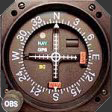
The MD200-306 is a panel-mounted Course Deviation Indicator (CDI) with rectilinear meter movements and contains integral GPS, NAV, and Back Course (BC) annunciators. The MD200-306 has a VOR/GPS needle, TO/FROM indicator, and NAV warning flag, plus a GS needle and flag. The MD200-306 contains an integral resolver for OBS function. The MD200-306 unit also features anti-reflective lenses and is backlit.
COM 2: Garmin SL-40

When panel space is at a premium, the SL40 VHF comm transceiver combines a lot of capability in a surprisingly small package.gh-Performance Space Saver
It’s an all-purpose, high-performance unit packed with innovative features not found on competitive units. In its space-saving 1.3 x 6.25-inch design, the SL40 incorporates such pilot-friendly features as active and standby flip-flop frequency tuning, direct sunlight-readable alphanumeric display, easy access to National Weather Service broadcasts, a two-place intercom, and more.Radios in One
The SL40's frequency-monitoring function gives you the ability to monitor ATIS or the 121.5 emergency frequency without leaving your assigned ATC channel. This allows you to listen to standby frequencies while giving priority to the active channel, meaning you'll never miss a transmission.
With 8 watts of transmit power and only 35-watt DC input, the TSO-certified SL40 is cool and efficient. No external fans or cooling equipment are required. And like the Garmin SL-30, the SL40 will operate on 10 to 32-volt inputs without the need or expense of a separate voltage converter. Maximum sophistication in minimum space: that’s the SL40.
760 communication channels
Frequency range: 118 to 136.975 MHz
Active and standby flip-flop frequencies
Volume control
16-character high-intensity alphanumeric LED display
Transmit status indicator
Backlit keypad controls
Automatic display intensity control
Built-in, two-place voice activated intercom
2x8 frequency memory and recall
Stores/recalls 8 user-defined frequencies
Stores/recalls previous 8 frequencies
Frequency monitor function (listens to standby while monitoring the active)
Dedicated emergency channel selector
Squelch test function
Stuck mic time-out
Audiopanel: Garmin GMA 340

Garmin's GMA 340 audio panel meets the needs of aircraft owners and operators who require reliability and versatility in the essential audio switching function.
The GMA 340 features innovative LED-illuminated push button controls that allow audio selection of both NAV and Comm audio. Large buttons activate the Comm microphone and audios for up to three Comm transceivers to simplify cockpit workload. Another feature of the GMA 340 is the Split Comm, which allows the pilot to transmit/receive on Comm 1 and the co-pilot to transmit/receive on Comm 2. MASQ™ processing reduces ambient noise from the avionics inputs. Comm transmit indication is also provided. Speaker selection is available to monitor the aircraft radios or to make PA announcements. There are two unswitched inputs for telephone ringers, altitude alert warnings, or other warning tones. In addition, the GMA 340 includes a six-place VOX intercom with three selectable modes of isolation, dual stereo music inputs, and independent pilot, co-pilot, and passenger volume control. Each microphone input has a dedicated VOX circuit to ensure that only the active microphone is heard when squelch is broken. Special cabin noise de-emphasis circuitry enhances cockpit communications. Also standard is the three-light Marker Beacon Receiver/Indicator with high/low sensitivity selection and SmartMute™ marker audio muting.
Surface mount technology provides shallow depth and light weight, which simplifies installation in the tightest aircraft spaces and saves precious panel space. Operation is available in 14 or 28 volts without voltage converters or dropping resistors. Installation is simplified with the built-in intercom and marker beacon, and the GMA 340 also features photo cell dimming of annunciators, pilot fail-safe mode connection to Comm 1, and FAA TSO approval.
Unit includes:
GMA 340 audio panel
Installation kit
Installation manual
Pilot's guide
Transponder: Garmin GTX-327

With the introduction of the GTX™ 327 solid-state Mode C digital transponder, Garmin® revolutionizes a part of the panel that has been long overlooked. This full-featured, TSO certified transponder brings a unique level of functionality and utility to your airplane. Its solid-state transmitter provides 200 watts nominal power output and eliminates the need for a cavity tube which, when it fails, will be expensive to replace. And since the GTX 327's design is 100 percent solid state, there's lower power consumption, much lower heat emission, and no warm up time—all of which translates into a longer service life.
Some of the GTX 327's biggest features are the easiest to see. Among them, the easy-reading DSTN Liquid Crystal Display which reverses the numbers out of black for optimal viewing. The numeric keypad makes entering a squawk code a snap, and a dedicated VFR button allows for quick-and-easy 1200/VFR squawking. The GTX 327 also offers important timing and display functions such as flight time and count-up and count-down timers, as well as current pressure altitude.Together, these features represent a whole new standard in transponder utility.
| SITUATIONAL AWARENESS: AvMap EKP-IV |

The AvMap EKP-IV Portable Moving Map GPS brings situational awareness to the next level. Featuring a new, more compact unit profile with an even LARGER and more brilliant color, sunlight-viewable LCD display. AvMap EKP-IV. redefining portable GPS moving map systems.
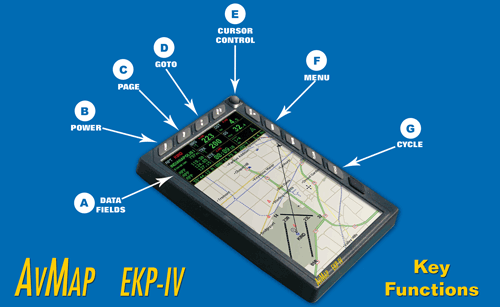
A) Data Fields - Monitors data related to the current flight. User can choose several screen options and preset data fields based on mode of flight. Options include: interim and final destination; waypoint/airport info; distance; ETE; ETA; bearing; cross-track error; GPS info; as well as vertical navigation, fuel consumption, A-B function and timers.
B) Power - Brightness & contrast control, power-on/off unit.
C) Page - Displays 'Nearest' functions to include: Airports; VORs; NDBs; Intersections; ARTCC and FSS Frequencies; Points of Information (POIs).
D) GoTo - Allows direct 'GoTo' to any of the following: Cursor location, Airports, VORs, NDBs, Intersections and User Waypoints.
E) Cursor Control - Provides full range of panning capability, as well as auto info on map and NavData.
F) Menu - Easy access to all navigation and mapping functions.
G) Cycle - Function allows user to scroll between three pre-set data screens.
| Harness: FastStack HUB |
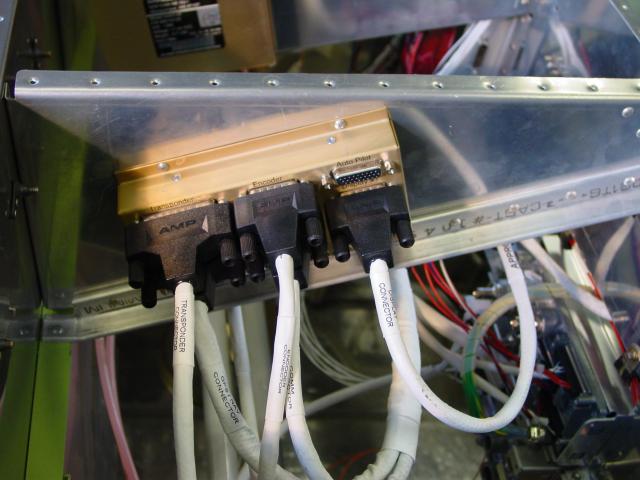
The Approach Pro Hub and Cable System is a complete solution delivering everything you need making avionic installs and upgrades fast, cost-effective and safe while eliminating the "rat's nest" behind the instrument panel. The Approach Pro Hub and Cable System is compatible with most NAV/GPS/COM, modern audio panels, intercoms, moving map displays, VOR indicators, HSI's, RMI's, ADF's, annunciators, mode control and just about any "send and receive" RS-232 formatted electronic device. The Approach Pro hub is designed for a full Garmin, Apollo, or Bendix/King stack.
The Approach Fast Stack Pro Hub is ideally suited for IFR configured instrument panels and can be retrofitted to any older or newer aircraft, certified or home-built. The Pro Wiring System is compatible with most NAV/GPS/COM, modern audio panels, intercoms, moving map displays, VOR indicators, HSI’s, RMI’s, ADF’s, annunciators, mode control and just about any “send and receive” RS-232 formatted electronic device. The Pro Wiring System is designed for a full Garmin, Apollo, or Bendix/King stack and includes an autopilot interface. The Pro Hub is compact and lightweight permitting installation anywhere behind the instrument panel. Simply select the appropriate Approach cables for your avionics, plug them in and you are done. All Approach cables are Milspec Tefzel with proper gauge and shielding. Cable ends are terminated with the right connector connecting the Approach Pro Hub to the avionics. Approach’ Fast Stack eliminates the time consuming, error-prone hand wiring methods used today and simplifies installs and upgrades by reducing the complicated technical details required for panel wiring. Labor charges, panel wiring scope creep, and aircraft downtime are drastically reduced. Approach’ Fast Stack avoids the problems of hand wiring by minimizing electronic noise and other associated problems by centralizing the grounding and utilizing uniform cable shielding and proper termination providing improved, lifetime avionic performance and a new level of safety. Approach designed its system for both newer and older aircraft, certified or home-built. Additionally, the wiring clutter typically found behind any instrument panel is finally eliminated. Approach will transform the way you think about avionic installs and upgrades with a simple and reliable solution making it easier than ever before to maintain your aircraft.
| ACK Technologies ELT Model E-01 |
This outstanding new ELT from ACK Technologies meets or exceeds all of the current requirements of TSO C91-A as specified by the FAA. It exceeds required power output by over 100% and it features coherent beacon designed for satellite detection. Also included is a miniature instrument panel controller for verification and testing of proper operation of the unit. Rated for full salt water immersion which far exceeds FAA TSO requirements. Comes complete with mounting tray, portable external antenna, installation harness, and life raft tether. This ELT uses standard alkaline "D" cell batteries which eliminates high replacement battery costs. Size: 7-3/4" x 2-3/4" x 2-3/4". Wt. 3.6 lbs.
I decided to put this beauty into my RV after the crash of our club plane "OO-ACS" last December (2005). It took more than 21 hours to retrieve the position of the aircraft. In the conditions of that season, men can survive for 5 hours maximum, before freezing to death... This little, unexpensive tool, can help you survive because rescue teams can localize a position in a very short time. And, safety is something for what I do NOT want to cut into the budget for this project...
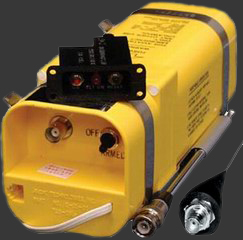
FEATURES:
Uses standard Duracell® batteries
Smallest, lightest TSO-C91a ELT available
Easy to install · Requires no aircraft power
Fire resistant, high impact plastic case
Waterproof to 60 ft.
Easily removed from aircraft for service
Coherent beacon designed for satellite detection
Two Year Warranty
| The first idea for my instrument panel |
I bought the Panel Planner software from ... . Playing around with the software I designed the first idea for my instrument panel. This is the FIRST IDEA and has to be fine tuned. But, nevertheless it already shows the direction I would like to follow. In the future I will update this until I (and my account) feels happy enough to make it final. So, here is the result...

My second idea. A little more detailed in the direction I prefer to go. Dark grey powdercoated panel with screen printed texts. The Gyro Horizon disappeared and I went to 3" Primary flight instruments. But, this is still ongoing. I have to calculate the budget too... But, nevertheless, this is going into the direction. Click on the panel to see a larger image...